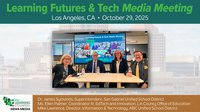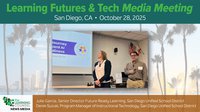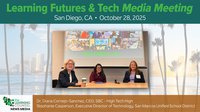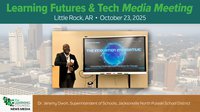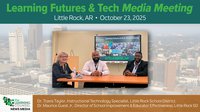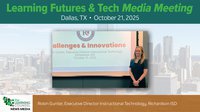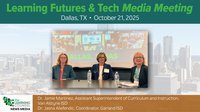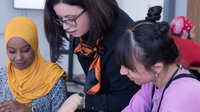My initial observation of my students during the time that I began providing increased digital educational experiences was that this type of learning commensurately reduced the amount of class time students spent interacting and communicating with each other and the teacher. Given that my students are at the age where they need to be developing crucial social skills, I sought to find the right balance between technical time and collaboration time while adding new educational technologies into my teaching repertoire.
When I first introduced my students to the collaborative writing program BoomWriter, they immediately loved creating their own “Boomers” (avatars) and the incentive of earning “BoomDollars” to buy avatar accessories generated interest in the writing assignments posted on the platform. This unprecedented excitement for writing enabled me to create powerful written-language learning activities that the children WANTED to do and do well.
I have used BoomWriter to teach writing across the curriculum. The ProjectWriter tool helps me create personalized learning experiences based on high-interest activities for an entire class, a small group, or individual students. Poetry Projects and group projects on specific areas of interest have fostered collaboration and peer editing among my students. Another innovative component of this platform is the WordWriter tool, which allows me to create activities and select specific vocabulary words to create a word bank for students to use. This tool not only helps struggling writers access higher-level vocabulary to frame their responses, but it also enables all students to practice using specific, grade-level words in their writing. This bolsters understanding and moves them towards using the vocabulary independently in speaking and writing, creating the gradual increase of responsibility for students. I have also created math projects in Word Writer, which allows me to embed specific mathematical vocabulary into each assignment.
Comprehensive rubrics embedded in the program are grade-level specific and are aligned with Massachusetts and Common Core standards. The rubrics have enabled me to accommodate and differentiate in my heterogeneous classes. I have also used the rubrics to provide a working guide for students to use as they complete their writing assignments.
To support digital organization of student work, communication with parents and students, and individual activities and group projects, I use Google Classroom and G-suite related products (Google Docs, Forms, Slides). G-Suite connects student and teacher drives so that assignments can be delivered electronically and in one place; it allows for more personalized and individualized educational learning experiences for students while also promoting digital citizenship, and it’s practically free.
National Geographic provides each of my students with online access through their Reach For Reading website. This new K–5 reading curriculum uses material from National Geographic and aligns with the Common Core. Schools that use Reach for Reading have access to National Geographic texts as well as videos and a digital library with images from the organization through a myNGconnect portal. The feature also provides students with digital editions of texts, vocabulary games, a word builder app, and a vocabulary notebook. It’s a wonderful tool for teaching and learning, it supports the curriculum at each grade level, and the activities are aligned with each unit of study.
Study Island is a great tool for review, homework, and test preparation. Test preparation, moreover, is critical for elementary students who, of course, need to become more familiar with, and eventually master, specific online features and tools as they begin computer-based standardized testing in grade 3. This platform combines grade-level content that is customized to state and Common Core Standards in math, reading, writing, science, and social studies. The platform also features games that engage students and both reinforce and reward learning achievement. I can use the information from the assessments embedded in the program to drive instruction and review. With just a glance at a spreadsheet, I am able to determine needs for review and instruction in specific areas of the curriculum for both the class and individual students.
Everyday Mathematics (EDM) online offers games for students, study links, information about homework and the lesson of the day, and interactive versions of the Student Reference Book. The site is infused with online math games and virtual math manipulatives that allow students to explore concepts more deeply. My students love the EDM games because they are fun and challenging, and kids can play with and against each other. I love these learning games because they support the curriculum and are linked to specific lessons, while at the same time providing exciting opportunities for collaboration. As a class, our favorite game is Divisibility Dash; notably, every single one of my students is working to beat the high score of 2096. This game provides practice with basic multiplication and division facts, while fostering higher-level thinking about factors, multiples, prime numbers, composite numbers, digit values, and extended multiplication facts. It’s a great warm-up for math or way to spend a few minutes winding down from a lesson. It makes learning fun.
To borrow from Thomas Paine, these are the tools that try the minds of students in these times.
Brenda Rogers has taught 3rd, 4th, and 5th grade for the Milton Public Schools over the past 17 years. She is a Massachusetts-certified Elementary Educator, Teacher of Reading, Middle School Teacher, and Social Studies Teacher.




